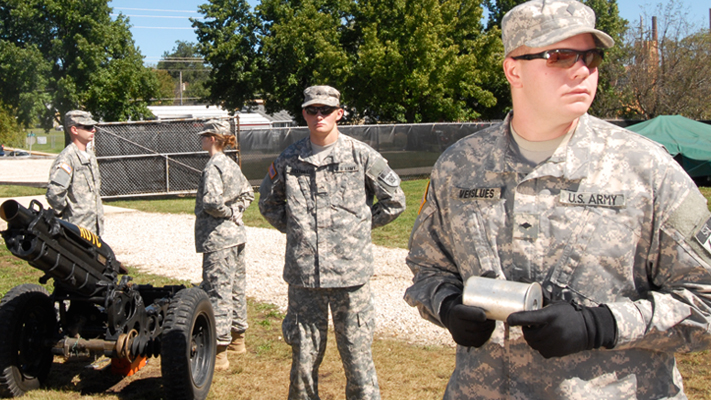Jordan Verslues hasn’t missed a single home football game at Missouri S&T during the past three years, and he’s on track for perfect attendance again this season.
But Verslues is no spectator in the stands. Nor is he on the playing field. But as leader of the Army ROTC’s cannon crew, the senior mining engineering major from Rocheport, Mo., plays an important role in every game.
At the moment of kickoff and whenever the Miners score, Verslues signals his crew to fire the battalion’s World War II-era 75-millimeter Pack Howitzer.
This is Verslues’ fourth year on the cannon crew and his first as crew leader. In that role, the Stonehenge Battalion cadet oversees the entire process of preparing the cannon for firing. Under his charge, one cadet loads the Howitzer with a canister containing a 10-gauge or 12-gauge black powder blank while two others act as sentries to keep spectators out of harm’s way. A fourth cadet pulls the lanyard to fire the cannon upon Verslues’ signal on kickoff or touchdown.
“It’s a pretty simple operation,” Verslues says. “There are only four moving parts when you disassemble it. But it seems like everybody on the crew enjoys it, and it brings more cadets to the football games. It’s a good way to be involved.”
Executing a flawless cannon shot takes split-second communication. Verslues must keep his eyes on the Miners’ kicker at kickoff and on the referees during a scoring drive, and must simultaneously hand-signal another cadet to fire the cannon.
Communication of a different sort is needed in another of Verslues’ roles. As the mapper for one of S&T’s Mine Rescue Teams, Verslues is responsible for keeping track of where equipment is located inside an underground mine during events like the Missouri Mine Rescue Contest, which is held every fall at S&T’s Experimental Mine. He also must relay information to team members above ground. “There is constant communication between the team in the mine and the outside,” he says.
After graduation, Verslues plans to go into active duty with the Army, then return to S&T to pursue a master’s degree in mining engineering.
He appreciates the ROTC program for providing “great leadership development,” and it has apparently paid off. Last summer, Verslues achieved one of the highest scores in his battalion during the 28-day Leadership Development and Assessment Course, held at Fort Lewis, Wash. The LDAP forms the core of ROTC cadets’ training program for cadets between their junior and senior years.
“The main goal is to evaluate what we’ve learned through our campus ROTC program, but our day-to-day activities are all run by us (the cadets),” Verslues says. “We rotate through the leadership positions throughout the program. So it tests you on how well you do as a follower and as a leader.”
Based on his high score in the LDAP and his commanding presence at the home football games, Verslues should have a booming military career.

Recent Comments